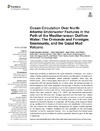Identificador persistente para citar o vincular este elemento:
https://accedacris.ulpgc.es/handle/10553/60074
| Title: | Ocean Circulation Over North Atlantic Underwater Features in the Path of the Mediterranean Outflow Water: The Ormonde and Formigas Seamounts, and the Gazul Mud Volcano | Authors: | Mosquera Giménez, Ángela Vélez Belchí,Pedro Rivera, Jesús Piñeiro, Safo Fajar, Noelia Cainzos Díaz, Verónica Balbín, Rosa Jiménez Aparicio, Juan Antonio Dominguez-Carrió, Carlos Blasco-Ferre, Jordi Carreiro-Silva, Marina Morato, Telmo Puerta, Patricia Orejas, Covadonga |
UNESCO Clasification: | 251007 Oceanografía física | Keywords: | Seamounts Mediterranean Outflow Water Taylor columns/caps Internal waves Cold-water corals |
Issue Date: | 2019 | Journal: | Frontiers in Marine Science | Abstract: | Seamounts constitute an obstacle to the ocean circulation, modifying it. As a result, a variety of hydrodynamical processes and phenomena may take place over seamounts, among others, flow intensification, current deflection, upwelling, Taylor caps, and internal waves. These oceanographic effects may turn seamounts into very productive ecosystems with high species diversity, and in some cases, are densely populated by benthic organisms, such corals, gorgonians, and sponges. In this study, we describe the oceanographic conditions over seamounts and other underwater features in the path of the Mediterranean Outflow Water (MOW), where populations of benthic suspensions feeders have been observed. Using CTD, LADPC and biochemical measurements carried out in the Ormonde and Formigas seamounts and the Gazul mud volcano (Northeast Atlantic), we show that Taylor caps were not observed in any of the sampled features. However, we point out that the relatively high values of the Brunt–Väisälä frequency in the MOW halocline, in conjunction with the slope of the seamount flanks, set up conditions for the breakout of internal waves and amplification of the currents. This may enhance the vertical mixing, resuspending the organic material deposited on the seafloor and, therefore, increasing the food availability for the communities dominated by benthic suspension feeders. Thus, we hypothesize that internal waves could be improving the conditions for benthic suspension feeders to grow on the slope of seamounts. | URI: | https://accedacris.ulpgc.es/handle/10553/60074 | ISSN: | 2296-7745 | DOI: | 10.3389/fmars.2019.00702 | Source: | Frontiers in Marine Science [ISSN 2296-7745], v.6 (702) |
| Appears in Collections: | Artículos |
Items in accedaCRIS are protected by copyright, with all rights reserved, unless otherwise indicated.
